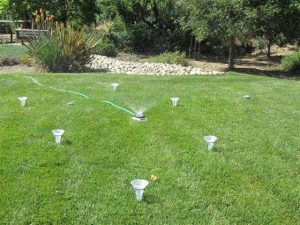A 50′ x 50′ lawn uses 3,115 gallons of water every time you turn on the sprinklers. In the prolonged drought California is experiencing, this isn’t sustainable. Landscape irrigation uses 54 percent of all residential water. Even turf advertised as drought tolerant is only relatively drought tolerant. To make matters worse, the California Department of Water Resources (DWR) estimates the population of California will grow to 45 million by the year 2020.
California Assembly Bill 1881 requires that the DWR report to the Legislature on the status of water-efficient landscape ordinances to be adopted by local agencies. On February 4, 2014, the Tuolumne County Board of Supervisors declared a state of emergency and required a 20% reduction in water usage. The Tuolumne Utilities District declared a further state of emergency and instituted a 50% reduction in residential water use.
AB 1881 also mandates that local agencies set up programs to encourage the capture and storage of rain water, proper implementation of irrigation systems and strongly advises planting drought-tolerant plants.
Part of the bill is geared toward professional landscapers and commercial landscapes. Local agencies must create a plan to require an assessment of how much water a landscape design will use before allowing its implementation.
What does this mean for the home gardener? This water shortage is real and, even if we get a good winter with plenty of rain and snow, there won’t be enough water to go around. While the population of California keeps growing, our water resources are dwindling. We all need to ensure that our own water will be wisely used. We can only do this by changing the way we choose plants.
For an extensive list of water-efficient plant ideas, visit the California Native Plant Society’s website. Our Tuolumne County Library has two first-rate books by Bornstein, Foss and O’Brien titled, “Re-imagining the California Lawn,” and “California Native Plants for the Garden.”
The “California Master Gardener Handbook,” published by the University of California, also at the Tuolumne County Library, provides essential advice encouraging early-season watering, “Most established drought-resistant plants on soil at least 4 feet deep should be able to survive in fairly good condition with no irrigation if they start the growing season with a soil reservoir full of water.”
In addition to early watering, mulch is excellent for conserving landscape water. A 3 to 4 inch layer around plants will cut down on evaporation and reduce weed problems as well as buffer soil temperatures. Mulch, such as decorative bark and gravel are readily available at local nurseries. Backyard compost used as mulch also prevents water evaporation, and is a great organic fertilizer.
The more severe our drought becomes, the more legislation will be passed to curb our thirsty English-style gardens and force us to recycle water. AB 1881 is only one of many future directives to the California Department of Water Resources to implement stringent ordinances to address our ongoing water problems. Instead of waiting until this happens, we can begin by replacing water-thirsty plants with natives and drought-tolerant ones.
Francie McGowan is a UCCE Master Gardener of Tuolumne County who has replaced her lawn with paver stones and drought-tolerant plants.


